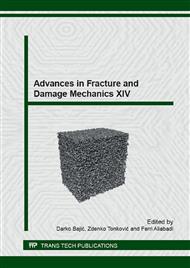p.21
p.25
p.29
p.33
p.37
p.41
p.45
p.49
p.53
Light Alloys Structural Behaviour in Severe Environmental Conditions
Abstract:
High strength-to-mass ratio light alloys, such as 7075-T6 aluminium alloys and Ti-6Al-4V titanium alloys, are commonly adopted for high performance structural components in the aeronautic, automotive and maritime sectors. For this reason, it is crucial to investigate the effects of the external environment on their mechanical properties, to avoid dramatic component failure. In the present work, experimental tests were performed on Ti-6Al-4V and 7075-T6 light alloys. Ti-6Al-4V notched flat dogbone specimens, with Kt = 1.18, were tested for quasi-static and SCC effects in a methanol-water aggressive environment at different concentrations. Rotating bending R = -1 fatigue tests were performed on 7075-T6 in air and methanol environment, to evaluate the effects of an aggressive environment on the fatigue strength at 200’000 cycles. The influence of DLC and WC/C PVD coatings on fatigue limit at 200’000 cycles has been evaluated in air and aggressive environment, to assess their mechanical and protective effects on the 7075-T6 substrate
Info:
Periodical:
Pages:
37-40
Citation:
Online since:
September 2015
Authors:
Keywords:
Price:
Сopyright:
© 2016 Trans Tech Publications Ltd. All Rights Reserved
Share:
Citation:


